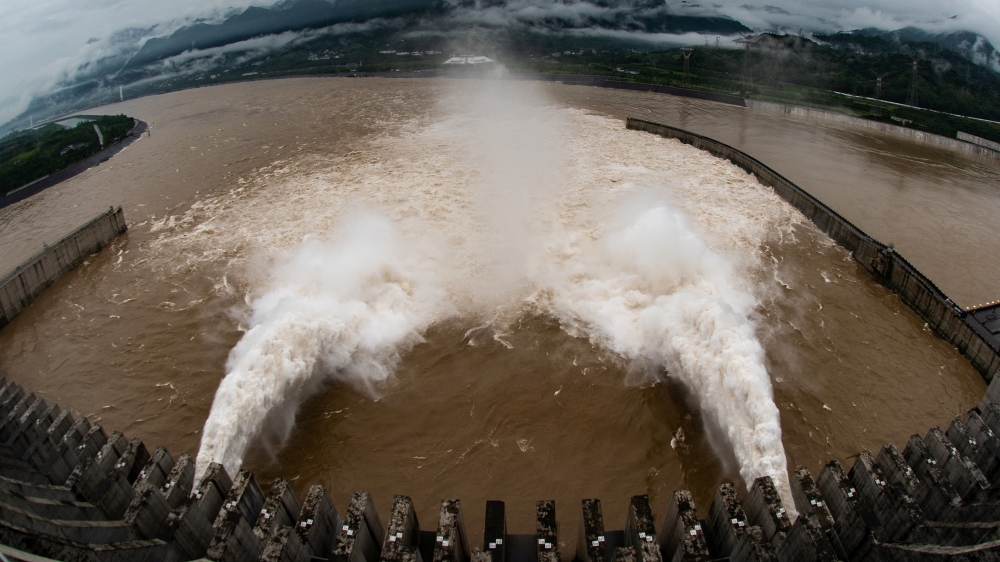Thousands evacuated in China after floods threaten villages
Rescue workers evacuate residents in Anhui and Hubei provinces as torrential rains continue to lash China.

China has evacuated tens of thousands of people in Anhui and Hubei provinces amid severe flooding and landslides triggered by some of the heaviest rainfall in decades.
In eastern Anhui, rescue workers evacuated 16,000 people from the town of Guzen after weeks of torrential rains caused a nearby river to overflow, China Global Television Network (CGTN) reported on Wednesday.
Keep reading
list of 4 itemsPhotos: Flash floods in Afghanistan devastate lives and livelihoods
Floods kill 50 people in northern Afghanistan’s Baghlan province
Brazilian horse ‘Caramelo’ rescued after being trapped on roof by floods
The flooding inundated 13 villages and cut off electricity to the whole region, it said.
A town called Guzhen in eastern China's Anhui Province has been hit by severe #flooding, trapping over 16,000 residents. After more than 50 hours of rescue work by air force, police and firefighters, all of those stranded have been evacuated. #ChinaFloods pic.twitter.com/gq09ULEFWK
— CGTN Global Watch (@GlobalWatchCGTN) July 22, 2020
In central Hubei province, more than 8,000 people were evacuated after a landslide blocked a river and created a barrier lake that threatened to submerge the city of Enshi and neighbouring villages, CGTN said.
The landslide occurred on Tuesday when 1.5 million cubic metres (53 million cubic feet) of earth fell into a tributary of the Yangtze river near Enshi, Xinhua news agency said, citing local authorities.
Over 8,000 people in China’s Hubei province have been evacuated after a massive #landslide blocked a river. #chinaflood pic.twitter.com/bHzFvwkRNI
— CGTN Global Watch (@GlobalWatchCGTN) July 22, 2020
China’s National Meteorological Center on Wednesday renewed a yellow alert for rainstorms throughout the country, warning local officials to be on the lookout for further flooding and mudslides.
Authorities have meanwhile declared red alerts in the provinces of Anhui and Jiangxi, which are bisected by the Yangtze, with China’s water resources ministry saying on Tuesday that water levels in the river and adjoining lakes would continue to rise.
Three Gorges Dam under pressure
Ministry officials said they needed to keep a close eye on water levels in the Three Gorges Dam, which has been storing huge volumes of water in order to ease downstream flood risks and is now 16 metres (52 feet) higher than its official warning level.
China’s giant dams, designed to contain floods and generate electricity, have come under heavy scrutiny in recent weeks. While officials have talked up their role in reducing flood peaks, critics say they not only fail to protect against extreme weather but also end up cutting flood storage capacity.

Dams block the flow of sediment and reduce the ability of downstream flood plains and wetlands to absorb floodwaters, said Darrin Magee, a professor at the Hobart and William Smith Colleges who specialises in China’s water issues.
The need to generate power can also undermine flood control efforts, he told Reuters news agency. “Flood control requires retaining water, and power production requires letting it out,” he said.
Seasonal flooding strikes large parts of China each year, especially in its central and southern regions, but conditions this year have been especially bad. Major cities have thus far been spared, but concerns have risen over Hubei’s capital, Wuhan, and other downstream metropolises that are home to tens of millions of people.
The flooding has forced evacuations of about 1.8 million people in 24 provinces, mainly in southern China, since the beginning of the month.
The Ministry of Emergency Management estimated direct flooding damage at more than 49 billion yuan ($7bn). The state-owned Global Times said on Wednesday that China’s finance ministry had allocated 830 million yuan ($118m) to “help 12 provinces hit hard by floods [to] resume agricultural production, repair water facilities and carry out reconstruction work”.
China’s worst floods in recent years were in 1998 when more than 2,000 people died, and almost 3 million homes were destroyed, mostly along the Yangtze.